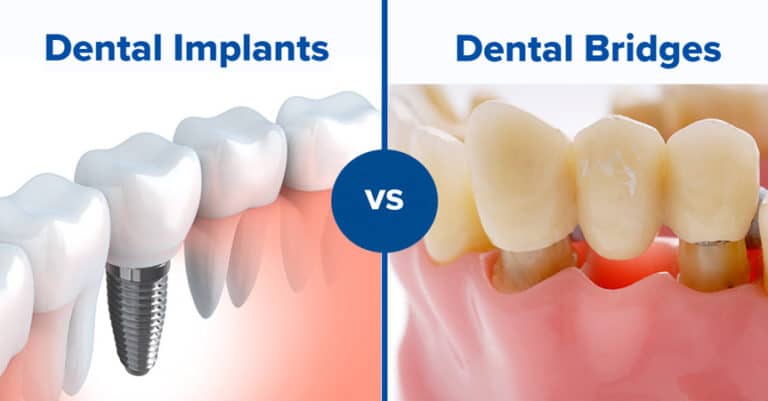Dental Bridges Versus Dental Implants: Making the Right Choice
When considering solutions for missing teeth, dental bridges, and dental implants are two prominent options. Both serve to restore function and appearance, but they differ significantly in procedure, longevity, and impact on oral health. Understanding these differences helps in making an informed decision tailored to individual needs and circumstances.
What Are Dental Bridges?
Dental bridges replace missing teeth by using adjacent teeth as anchors. The procedure involves placing crowns on the adjacent teeth and attaching a false tooth (pontic) between them. This setup “bridges” the gap created by one or more missing teeth.
Procedure and Maintenance of Dental Bridges
The process for getting a dental bridge typically spans two visits. During the first visit, the dentist prepares the abutment teeth (the neighboring teeth) by removing a portion of enamel to accommodate the crowns. Impressions are then taken to create a model for the bridge. A temporary bridge is placed to protect the exposed teeth and gums. On the second visit, the temporary bridge is removed, and the custom-made bridge is fitted, adjusted, and cemented into place.
Maintenance for dental bridges involves regular brushing and flossing, similar to natural teeth. Special care is required to clean under the pontic to prevent decay and gum disease.
Pros and Cons
The primary advantage of dental bridges is that the procedure is less invasive and requires less time compared to implants. Bridges also cost less upfront and are covered by most dental insurance plans. However, they may need replacement every 5-15 years. Additionally, the preparation of abutment teeth involves removing healthy tooth structure, which can compromise the long-term health of these teeth.
What Are Dental Implants?
Dental implants are a more modern solution for missing teeth. They involve surgically placing a titanium post into the jawbone, which acts as a root for the artificial tooth. A crown is then attached to the post, providing a stable and permanent solution.
Procedure and Maintenance of Dental Implants
The dental implant process takes several months. Initially, the implant post is surgically placed into the jawbone. Over the next few months, the bone grows around the implant in a process called osseointegration, securing it firmly in place. Once the implant is stable, an abutment is attached to the post, and a custom-made crown is placed on top.
Implants require similar maintenance to natural teeth, including regular brushing, flossing, and dental check-ups. Proper oral hygiene is essential to prevent peri-implantitis, an inflammatory condition that can cause implant failure.
Pros and Cons
The main benefit of dental implants is their durability. With proper care, implants can last a lifetime. They also help preserve the jawbone, preventing bone loss that typically occurs with missing teeth. Implants do not affect adjacent teeth, maintaining the integrity of surrounding teeth.
However, dental implants require a more invasive surgical procedure and a longer healing period. They are generally more expensive than bridges, and the higher upfront cost may not be fully covered by dental insurance. Additionally, not all patients are suitable candidates for implants, particularly those with insufficient bone density or certain medical conditions.
Dental Bridge vs. Implant: Which Is the Right Choice for You?
Choosing between dental bridges and dental implants depends on several factors, including oral health, budget, and personal preferences.
Oral Health Considerations
Patients with healthy adjacent teeth and gums may benefit from a dental bridge, especially if they prefer a quicker and less invasive procedure. Those with compromised teeth or insufficient bone density may find implants less suitable without additional procedures like bone grafting.
Financial Considerations
Budget plays a significant role. While implants have higher upfront costs, their longevity might offer better value over time. Conversely, bridges are more affordable initially but may require future replacements.
Lifestyle and Preferences
Patients should also consider their lifestyle and how each option fits into their routine. Implants, being more permanent, might suit those seeking a long-term solution without future dental work. Bridges, requiring simpler procedures, might appeal to those wanting immediate results.
Conclusion
Both dental bridges and dental implants offer viable solutions for missing teeth, each with distinct advantages and considerations. Consulting with a qualified dentist is crucial to determine the best option based on individual needs.
About Dr. Molly Rodgers Dental
Dr. Molly Rodgers Dental, located in Edmonton, Canada, provides comprehensive dental care, including dental bridges and implants. With a focus on patient-centered care and advanced dental solutions, Dr. Molly Rodgers and her team are committed to helping patients achieve optimal oral health and confident smiles. Schedule a consultation today to explore your options and receive personalized care tailored to your dental needs.

